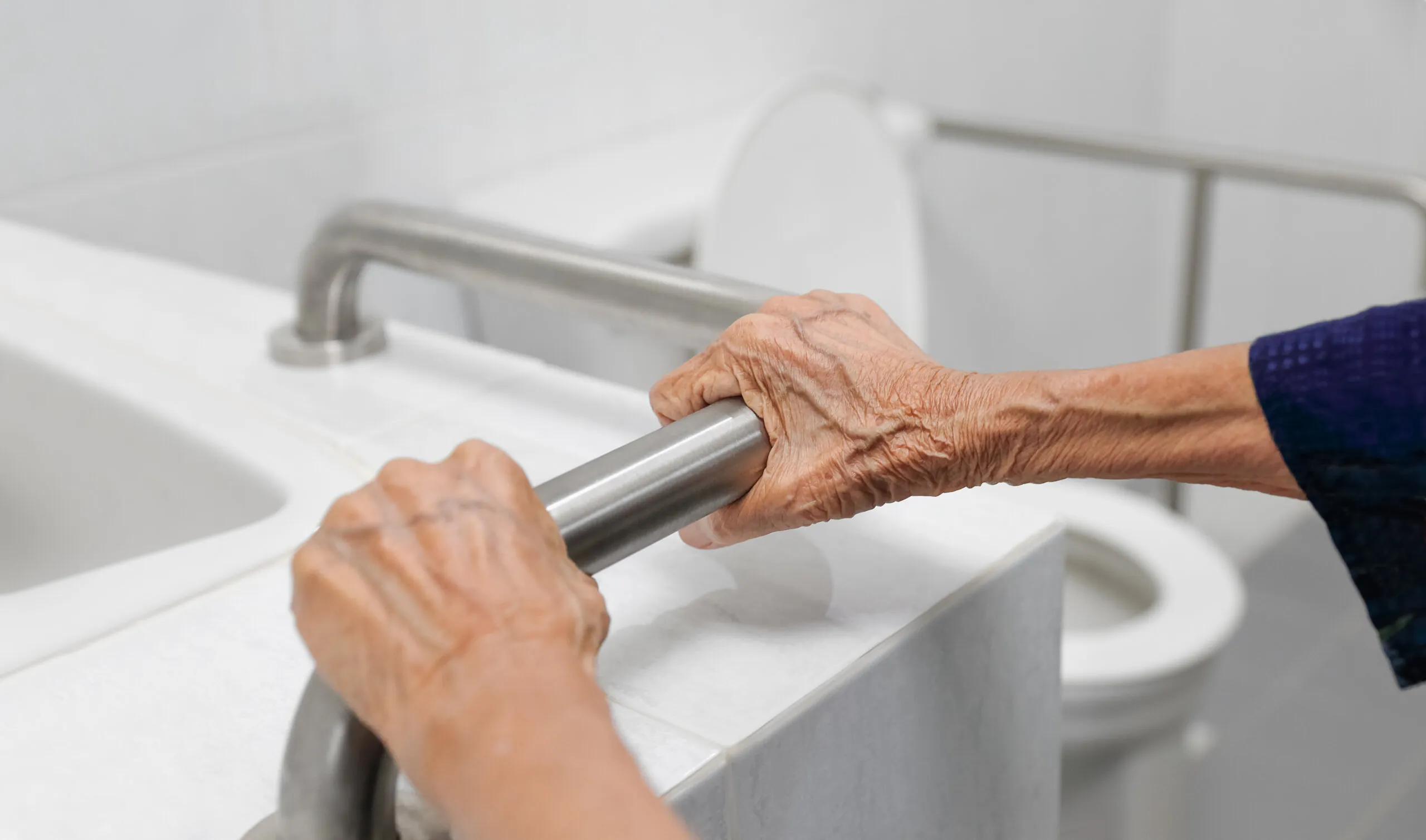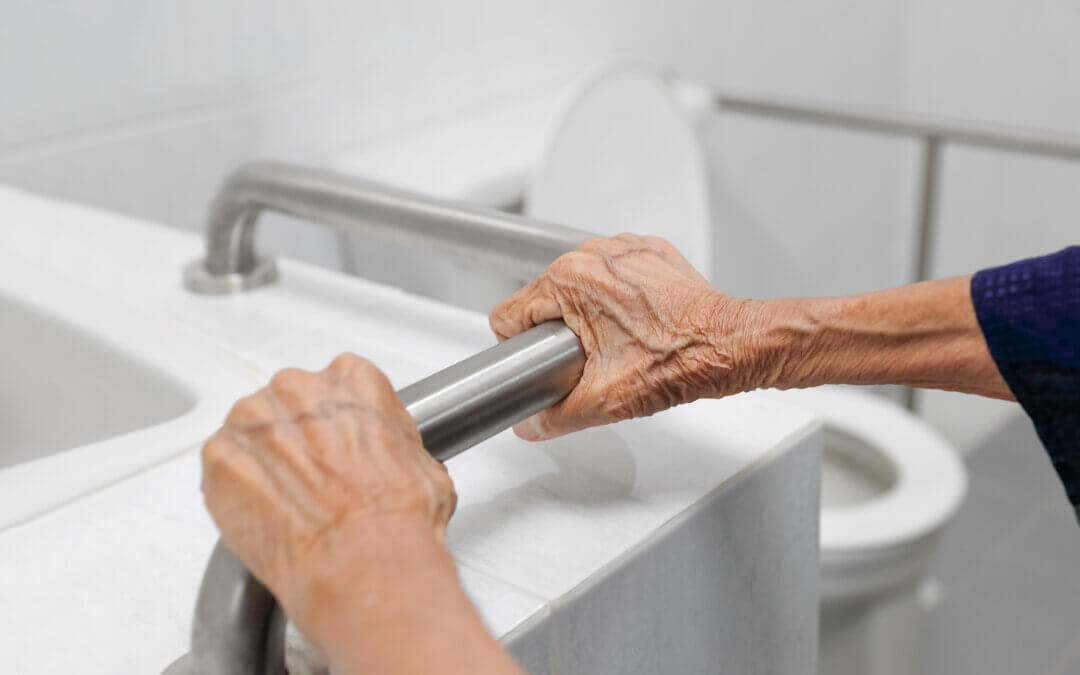
Your everyday shower or bath should be a relaxing experience, not a safety hazard. With the many risks in a bathroom, slips and falls may be a hazard for anyone using it, especially the elderly and the disabled, causing severe injuries. Implementing the right tools and measures can increase your bathroom’s safety and security.
If you’re looking for prevention methods for your bathroom and need some helpful advice, here are our best tips on controlling bathroom slips and falls.
Want a safer bathroom?
Simply complete our form to see a full range of bathing solutions & their key features. It takes no time at all!
- Swap out fabric rugs for non-slip mats
- Install handlebars or rails
- Install grip measurements in your bathtub
- Utilise a shower chair
- Invest in a bath or transfer bench
- Install a raised toilet seat
- Place shelves at eye level
- Use a nightlight or motion sensor
- Removing obstacles
- Install an adjustable showerhead
- Regular cleaning
- Keeping the bathroom dry
- Take your time
1. Swap out fabric rugs for non-slip mats
Accidents occur when stepping in and out of the tub and shower or using the toilet, and fabric rugs can increase the likelihood of slipping. These rugs may look aesthetically pleasing, yet, non-slip mats will help prevent any type of slip or falls in the bathroom. If you’ve slipped in the shower before, you know how scary it can be and why changing all the rugs can have a massive impact.
Alternatively, rather than removing the rugs, there’s the option to secure rugs with slip-resistant tape or backing from the bathroom. Apply the non-slip backings directly to the rugs and floor for the full effect.
2. Install handlebars or rails
Growing older, keeping balance can be difficult, especially on wet and slippery surfaces and lifting yourself. Installing rails or handlebars throughout the bathroom, including by the toilet and around the tub and shower, can create a sturdy surface. Whatever the size and shape of your bathroom, rails and bars vary in shape, placed accordingly.
Try to avoid finding substitutes for these rails, such as shelves or soap dishes, as they might not be able to hold your weight and can cause further accidents and injury.
3. Install grip measurements in your bathtub
As the most slippery part of the bathroom, especially when using the bathtub, it’s crucial to put measurements in place to control accidents.
Use non-slip strips or mats in the bathtub, providing extra grip when moving around and getting in and out of it. Ensure the mat is fully secured and doesn’t move around; the same goes for the strips.
4. Utilise a shower chair
Growing older, standing for long periods or moving around can become challenging, especially when you shower or bathe. Shower chairs offer reassurance and ease, containing slips and falls with something extra to hold.
Before purchasing, ensure the chair has a non-slip seat and rubber tips, preventing it from sliding around in your bath or shower. When it comes to having a bath, they also come in handy, as you can sit rather than lay, making it easier to get up afterwards.
5. Invest in a bath or transfer bench
Stepping out of the bath provides great difficulty if your mobility isn’t what it used to be, yet, a bath bench can help.
Bath benches offer accessibility, reassurance and independence for bath time, extending over the side of the bathtub with two legs resting on the floor. It allows you to sit and swing your legs into and out of the tub, securing yourself as you stand up.
Walk-in baths are especially beneficial for those with mobility issues, including arthritis, or some kind of disability, or those who have a carer. By having a door that you can open and walk into the bath, you eliminate the need to step over the side of the bath and potentially slip and fall. People around the world are learning about walk-in baths and wet rooms and the benefits they bring, so if you’re interested in learning more, then you should enquire with us.
6. Install a raised toilet seat
Lower toilet seats create challenges when getting up safely or require more effort, especially if you have mobility issues. With a raised toilet seat or toilet seat extender, the height increases by 3 to 4 inches more than a standard toilet seat, reducing the effort when going to the toilet.
7. Place shelves at eye level
Reaching or bending down for toiletries or toilet paper when using the toilet, bath, and shower can be difficult for seniors or those with reduced mobility.
Placing the shelves at eye level reduces the need to reach up for toiletries or lower yourself into the vanity. Shower caddies or bath trays can also help with toiletry storage, controlling the risk of injury in the bathroom.
8. Use a nightlight or motion sensor
Prepare for nighttime bathroom visits with a nightlight or motion-sensor lighting to ensure adequate light is available. Adding light to the hallway or the path from the bedroom and living areas to the bathroom benefits accessibility.
You can use a nightlight, a motion sensor to come on when someone enters the room or glow-in-the-dark stickers to help brighten the way and reduce the opportunity for injury.
9. Removing obstacles
Tripping is one of the most considerable risks for the elderly, whether it’s the bathtub or any items which are safety hazards. The best way is to remove obstacles, reducing the risk of tripping and replacing the existing bath or shower with the walk-in type, preventing additional accidents. Walk-in baths or walk-in showers decrease the risk of falling over the bathtub’s side.
Additionally, toiletries can become hazardous when spilt on surfaces or the floor. With this in mind, ensure toiletries are of reach and easy to access but are closed off enough that they won’t spill anywhere, causing slipping incidents.
10. Install an adjustable showerhead
Mobility issues create challenges whilst showering, such as using the shower head. An adjustable or hand shower head minimises the movements in the shower or can be used safely with a shower seat.
The water flow can also be in one direction, controlling any water spillage and containing it from happening. Without an adjustable shower head, water can be sprayed across more areas, creating more opportunities for slipping over.
11. Regular cleaning
Cleaning your bathroom is crucial to care for your health and prevent slips and falls. For example, soapy residue or mould can create slippery or unsteady surfaces, causing some accidents. Maintaining your bathroom also prevents damage to the facilities, aiding overall safety.
12. Keeping the bathroom dry
Although keeping the shower or bathtub dry after use is challenging, you can control other areas, such as the floor and surfaces.
Use a weighted shower curtain, ensuring no water leaks onto the floor. If any excess water leaks, lay down a towel to wipe it up or use a non-slip mat on the floor to prevent hurting yourself.
13. Take your time
Rushing around is the key to causing accidents, as you’re not thinking about any potential hazards your bathroom has. Take your time when using the toilet, having a shower or a bath, and applying our advice on bathroom safety.
Being slower in your movements allows you to enjoy the pleasure of bathing and relaxing, reducing your chance of falling or slipping over.
What is the most effective way to prevent slips?
Utilising bathroom aids such as shower chairs, handrails, non-stick mats, raised toilet seats, and adjustable shower heads are a few ways to help prevent accidents in the bathroom.
These methods create a safety barrier to enable the bathroom to become a more accessible and inclusive space for the elderly or the disabled.
Although these methods are beneficial, for the best impact, invest in a walk-in shower, bath or wet room, as they are specifically designed to help those with limited mobility bathe safely and easily.
How do I make the rest of the house safer?
Preventing falls at home requires attention to key areas. Start by ensuring hallways and stairs remain well-lit and free of clutter, with secure handrails installed for support. Be cautious of patterned carpets that may cause visual confusion.
In living spaces, arrange furniture to maintain clear pathways and select chairs and beds at appropriate heights. Those with balance concerns should sit while dressing. Kitchens present particular risks, so store everyday items within easy reach and use wheeled carts when moving multiple objects.
Conducting regular home safety checks can significantly reduce fall hazards and promote confident mobility throughout your living space.
Whether you’re looking to install any safety precautions to help keep your bathroom accessible, Bathing Solutions’ installation services help those with limited mobility bathe safely. Contact our team today to help with the installation of walk-in baths and showers and for bespoke bathroom design.
FAQs (Frequently Asked Questions)
What do I do if I fall?
If you can get up: Roll to your side, push up to your hands and knees, find support (like a sink), and stand slowly while holding on. Rest afterwards.
If you can’t get up: Call for help if possible, stay warm, and shift positions every 30 minutes until assistance arrives.
Visit the NHS guidance on falls or consult a medical professional for more information.
How to stop slipping in the bath?
Use a non-slip bath mat or stick-on safety strips, install a grab rail for support, and consider a bath seat if needed. Always take your time getting in and out.
Why are bathrooms slippery?
Bathrooms get slippery because of water + smooth surfaces (like tiles or acrylic baths). Soap, shampoo, and body oils make it worse by creating a slick film.






